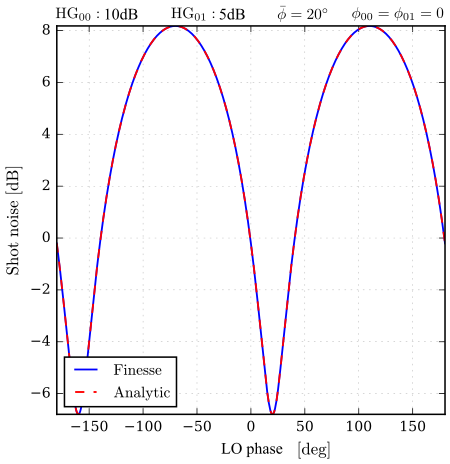Multiple Spatial Mode Squeezing and its Detection
(An optics simulation with Finesse)
The following shows a simple example for a Finesse simulation of multimode squeezing. The term 'multimode squeezing' refers to the individual squeezing of the fundamental mode and some higher-order optical modes, which is different from a change of mode basis for a single-mode squeezed field.
The input file
#-------------------------------------------------------------------------------------- # Finesse input file to model multimode squeezing for the fundamental # and the higher-order Hermite Gaussian modes. # Alex Wormald, 04.11.2016 #-------------------------------------------------------------------------------------- ## Setting up the optical system ## l L0 1k 0 nL0 # Local oscillator sq SQ1 0 10 20 nS # Squeezer # Beam splitter (R = 0.999 to suppress vacuum noise from LO port) bs BS 0.999 0.001 0 45 nL0BS nYBS nXBS nSBS s lBS 1 nL0 nL0BS # Space (LO to beam splitter) s lX 1 nXBS nX # Space (BS to detector) s lS 1 nS nSBS # Space (Squeezer to BS) ## Define the mode content for LO and squeezer maxtem 1 # consider only one higher-order mode tem L0 0 0 1 0 # 00 mode tem L0 0 1 1 0 # 01 mode (here we consider 50/50 mix of 00 and 01) tem SQ1 0 0 1 0 # 10dB squeezing for 00 tem SQ1 0 1 0.5 0 # 5dB squeezing for 01 ## Simulation instructions ## #Setting the frequency for computing the quantum noise (exact value does not matter) fsig noise 1k qnoised sqzd 1 $fs 0 nX # Quantum noise detector xaxis L0 phi lin -180 180 500 # Varying the local oscillator phase yaxis lin abs
To add extra, squeezed, higher-order modes, the general form for the tem command is given by; 'tem SQ1 n m factor phase'. Here, "factor" scales the squeezing magnitude (dB) and "phase" offsets the squeezing angle (degrees), both relative to the global values set by the squeezer command "sq".
The optical layout

The given optical setup for detecting the squeezed field. A local oscillator (LO) and squeezed light beam are combined by a high-reflectivity beam splitter which is used to suppress the noise from the LO. The propagation distance is set to be the same for both beams so that the choice of mode basis is consistent after propagation.
Output graphs

The above graph compares the shot noise of multimode squeezed light generated by Finesse with the analytic result, see below, as a function of the phase difference between the squeezed light and the LO. \(\phi_{mn}\) denotes squeezing angle for mode \(mn\), relative to the global phase \(\bar \phi\) defined by the squeezer command.
The power spectral density for the shot noise is given by
\(P\hbar\omega_0R T\left[ e^{-2r_{00}}\cos^{2}({\bar\phi+\phi_{00}})+e^{2r_{00}}\sin^{2}({\bar\phi+\phi_{00}})+e^{-2r_{01}}\cos^{2}({\bar \phi + \phi_{01}})+e^{2r_{01}}\sin^{2}({\bar\phi+\phi_{01}})\right]+2P\hbar\omega_0 T^{2}\)
Here \(P\) is the LO power; \(R\) and \(T\) are the power reflection and
transmission coefficients of the beam splitter; \(r_{00}\) and
\(r_{01}\) are the squeezing factors for \(\rm HG_{00}\) and \(\rm
HG_{01}\), where 10dB squeezing means \(\log_{10} e^{2r}=10\);
\(\omega_0\) is the frequency of the LO. \(\hbar\) is the Planck's
constant. We have assumed that the mode content for the local
oscillator is 50/50 \(\rm HG_{00}\) and \(\rm HG_{01}\), which is
the case in the above simulation. The last term is the
contributed by the vacuum fluctuation from the LO port, which is
negligible for given high \(R\).


